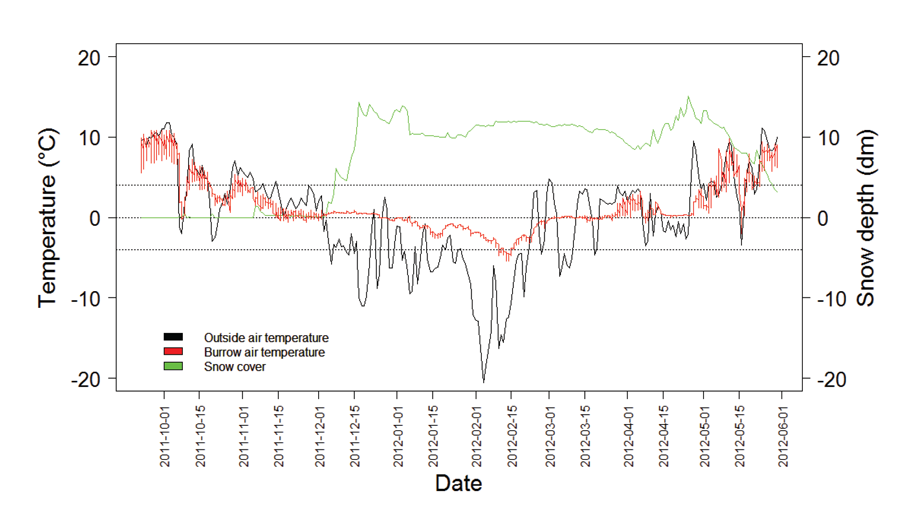
Ecological Archives E094-050-A4
Marion Tafani, Aurelie Cohas, Christophe Bonenfant, Jean-Michel Gaillard, and Dominique Allainé. 2013. Decreasing litter size of marmots over time: a life history response to climate change? Ecology. 94:580–586. http://dx.doi.org/10.1890/12-0833.1
Appendix D. Additional information on burrow temperature and efficiency of snow insulation during winter.
During hibernation, Alpine marmots have to spend energy for maintaining body temperature above 5°C whenever the burrow air temperature decrease below this threshold (Arnold et al. 1991). Although a deep snow cover during winter can act as an insulation layer, it can be insufficient to prevent frost from reaching deep underground and burrow air temperature to decrease below 5°C (Arnold et al. 2011). To prove this latter assertion, and similarly to show that in our study site, both a deeper snow cover and a warmer temperature in winter can limit the decrease in burrow temperature, henceforth reducing fat depletion of Alpine marmots; we present here the measurement of burrow air temperature during winter 2011–2012 at La Grande Sassière Nature Reserve (Fig. D1).
Methods
Starting from late September 2011, we collected temperature data at Alpine marmots’ burrow entrance (around 1 m underground) using temperature loggers (HOBO UA-002-08 Pendant Temp/Light). The main chamber of the burrow was unfortunately not accessible to us because it is really difficult to locate. In Fig. D1, we present an example of a time-series of the burrow temperature, outside air temperature, and snow depth we obtained.
Results
When snow cover is absent, the correlation between burrow temperature and outside air temperature is high (r² = 72%; p < 0.001). When snow layer is >110 cm on average, the burrow temperature is buffered against variation in air temperature. Burrow temperature is stable around -5°C to 0°C and the r² of the linear relationship between air and burrow temperature drops to 58 % (p < 0.001). When temperature decreases below -10°C, even with a snow layer of >110 cm, the burrow temperature can drop down to -5°C for several days in a row. We observed that burrow temperature, while being warmer than outside air, still decreases with a slight delay of a couple of days when air temperature reaches its minimum between the end of February and early March.
These results demonstrate that, the snow layer, even when deeper than 100 cm, does not prevent the burrow’s air temperature to reach -5°C at one meter underground in mid-February, a temperature at which the energy expenditure for marmots becomes quite high as the critical point is 5°C for marmots (Arnold et al. 1991). The insulating power of snow depth in our study site is important but not sufficient to prevent any energy expenditures during hibernation.
Fig. D1. Daily air temperature (in black), inside burrow air temperature (around 1 m deep in the ground, in red) and snow cover (in green) during the 2011–2012 winter. Isotherm 5°C, 0°C, and -5°C are represented in dotted lines.
Literature Cited
Arnold, W., G. Heldmaier, S. Ortmann, H. Pohl, T. Ruf, and S. Steinlechner. 1991. Ambient temperatures in hibernacula and their energetic consequences for alpine marmots (Marmota marmota). Journal of Thermal Biology 16:223–226.
Arnold, W., T. Ruf, F. Frey-Roos, U. Bruns 2011. Diet-Independent Remodeling of Cellular Membranes Precedes Seasonally Changing Body Temperature in a Hibernator. PLoS ONE 6:e18641.